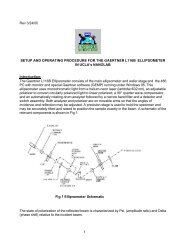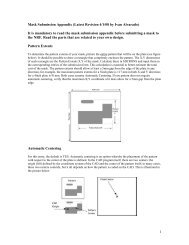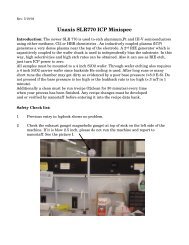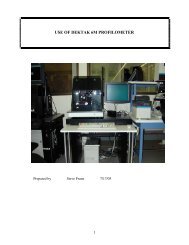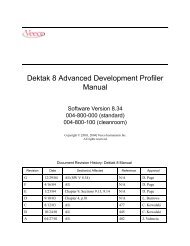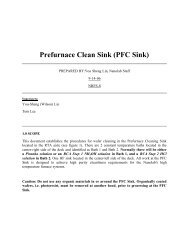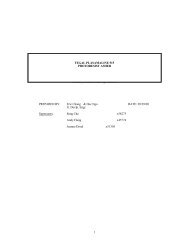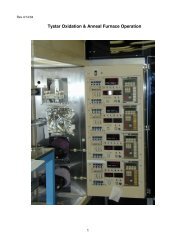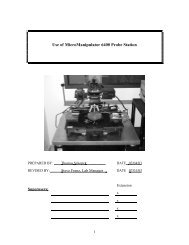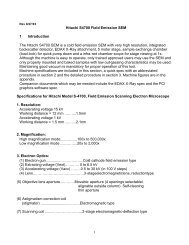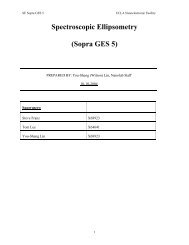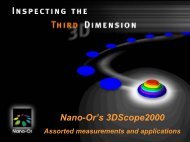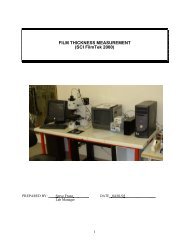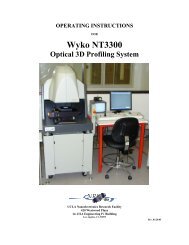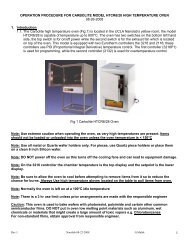recommended lithography procedure for az5214 resist positive tone ...
recommended lithography procedure for az5214 resist positive tone ...
recommended lithography procedure for az5214 resist positive tone ...
Create successful ePaper yourself
Turn your PDF publications into a flip-book with our unique Google optimized e-Paper software.
RECOMMENDED LITHOGRAPHY PROCEDURE<br />
FOR AZ5214 RESIST<br />
5 Soft Bake:<br />
A Hot Plate: 1 minute @105°C<br />
OR<br />
B Oven: 20 minutes @ 95°C<br />
6 Exposure:<br />
Exposure depends on <strong>resist</strong> thickness, lamp intensity and many other variables, but <strong>for</strong><br />
4000 rpm with exposure intensity at 13mW/cm2, (280W, lamp power), 4-6 seconds is a good<br />
starting point on the Nanolab Quintel.<br />
7 Develop:<br />
Develop in beaker with 5:1 water: AZ400K developer with constant gentle agitation. (You<br />
should try to keep this step constant and adjust your exposure in step 6 to get desired<br />
results. Also softbaking affects this step greatly. Underbaked <strong>resist</strong> will develop very fast<br />
with little control. Overbaked <strong>resist</strong> will develop slowly and may not clear at all.) Rinse in<br />
flowing DI water immediately <strong>for</strong> at least 2 minutes and blow dry with nitrogen. (Do not allow<br />
water to evaporate).<br />
8 Postbake:<br />
Hotplate: 2 minutes @150°C<br />
OR<br />
Oven: 30 minutes @120°C minimum<br />
Note: This step depends heavily on etch or ion implant step. Higher temperatures help<br />
image stability, adhesion and plasma/chemical <strong>resist</strong>ance but above 120°C, stripping PR<br />
requires O2 plasma, acid strip or AZ300T. Postbake up to 150°C may be done without <strong>resist</strong><br />
flow.<br />
9 Descum:<br />
It is strongly <strong>recommended</strong> that an oxygen plasma descum step be used especially <strong>for</strong><br />
small geometries such as contacts and vias and especially if a dry etch step is being used.<br />
The RIE should be used with O2 at a power of maybe 100-150W to remove about 500Å of<br />
PR. Use the Nanospec to verify proper PR removal. If wet etching without this step appears<br />
to be taking longer than calculated then a PR scum layer may be interfering with the etch<br />
and the addition of this step may be required.<br />
10 Wet Etch:<br />
For Oxide etching it is <strong>recommended</strong> to use BOE etchant rather than HF-water mixtures.<br />
Undercut and <strong>resist</strong> lifting are much worse <strong>for</strong> HF-water than <strong>for</strong> BOE. For very long etches<br />
(~hrs) even in BOE, lifting may occur. For these cases, intermittent hard baking, <strong>resist</strong><br />
hardening (UV or PRIST) or the use of a hard mask may be necessary.<br />
11 PR Stripping:<br />
For photo<strong>resist</strong> NOT exposed to ion beams, plasmas or temperatures in excess of 120°C,<br />
AZ 1500 Thinner or ace<strong>tone</strong> may be used. Otherwise AZ300T stripper, O2 plasma or an acid<br />
strip (Pirhana, Caros acid etc.) may be used (depending on the underlying layer). Wafers<br />
must be free from old photo<strong>resist</strong> and organics be<strong>for</strong>e recoating them.<br />
2



